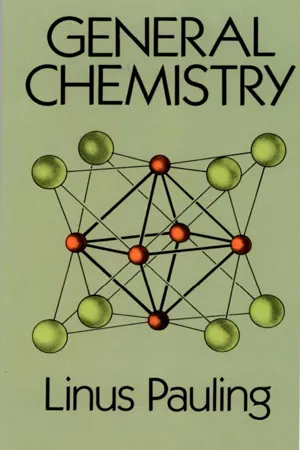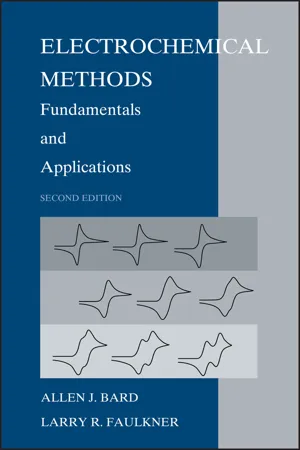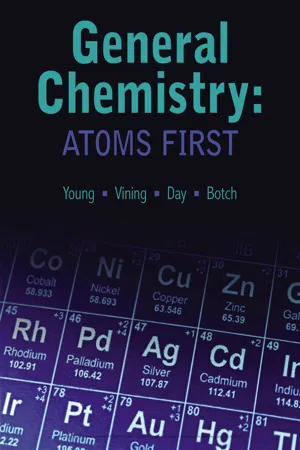Chemistry
Electrolysis of Ionic Compounds
Electrolysis of ionic compounds involves the breaking down of the compound into its constituent elements using an electric current. This process occurs in an electrolytic cell, where positive ions migrate to the negative electrode (cathode) and negative ions migrate to the positive electrode (anode). At the electrodes, the ions gain or lose electrons, resulting in the formation of new substances.
Written by Perlego with AI-assistance
Related key terms
1 of 5
9 Key excerpts on "Electrolysis of Ionic Compounds"
- eBook - PDF
Foundations of Chemistry
An Introductory Course for Science Students
- Philippa B. Cranwell, Elizabeth M. Page(Authors)
- 2021(Publication Date)
- Wiley(Publisher)
Philippa B. Cranwell and Elizabeth M. Page. © 2021 John Wiley & Sons Ltd. Published 2021 by John Wiley & Sons Ltd. Companion website: www.wiley.com/go/Cranwell/Foundations • Describe how electrolysis can be used to decompose ionic substances to obtain elemental species • Identify the oxidation and reduction reactions occurring at the electrodes in simple electrolytic cells, and write half-equations for these processes • Calculate the amount of substance deposited in an electrolysis reaction from a knowledge of the current and time used 9.1 Introduction Earlier in this course, in Chapter 5, we saw that many chemical reactions involve the transfer of electrons in oxidation and reduction reactions, known collectively as redox processes . In a redox reaction one chemical species is oxidised and another reduced and electrons are transferred in the process. This movement of electrons can be harnessed within electrochemical cells, and the current gen-erated used to do work in batteries or fuel cells which are used extensively in a wide range of electronic equipment from mobile phones to vehicle engines. The individual half-equations that make up redox reactions are equilibrium processes that can proceed in either direction depending upon the half-reaction that they are coupled with. The generation of current in this way can be reversed by providing electrons from an external source, such as a power supply. This reverse process is called electrolysis and involves using an electrical charge to electrolyse or split a sub-stance into its individual components. Electrolysis is an important industrial process used in metal extraction to obtain pure metals such as aluminium from oxide ore and to produce essential industrial raw materials such as bromine, obtained by the electrolysis of seawater, or chlorine, which can be extracted from brine or concentrated sodium chloride solution. - eBook - ePub
- Linus Pauling(Author)
- 2014(Publication Date)
- Dover Publications(Publisher)
15 Oxidation-Reduction Reactions. Electrolysis It was mentioned in Section 6-8 that in the period from 1884 to 1887 Svante Arrhenius developed the theory that electrolytes (salts, acids, bases) in aqueous solution are dissociated into electrically charged atoms or groups of atoms, called cations and anions, and some of the properties of these solutions were discussed in Section 13-11. The present chapter is devoted in part to the phenomena involved in the interaction of molten salts and ionic solutions with an electric current. It is found that the electron reactions that take place at electrodes can be described as involving oxidation or reduction of atoms or groups of atoms, and that the chemical reactions called oxidation-reduction reactions (sometimes shortened to redox reactions) can often be conveniently described in terms of two electrode reactions. 15-1. The Electrolytic Decomposition of Molten Salts The discovery of ions resulted from the experimental investigations of the interaction of an electric current with chemical substances. These investigations were begun early in the nineteenth century, and were carried on effectively by Michael Faraday (1791-1867), in the period around 1830. The Electrolysis of Molten Sodium Chloride Molten sodium chloride (the salt melts at 801°C) conducts an electric current, as do other molten salts. During the process of conducting the current a chemical reaction occurs; the salt is decomposed. If two electrodes (carbon rods) are dipped into a crucible containing molten sodium chloride and an electric potential, from a battery or generator, is applied, metallic sodium is produced at the cathode and chlorine gas at the anode. Such electric decomposition of a substance is called electrolysis. The Mechanism of Ionic Conduction Molten sodium chloride, like the crystalline substance, consists of equal numbers of sodium ions and chloride ions. These ions are very stable, and do not gain electrons or lose electrons easily - H. Ch. Curtius, Marc Roth(Authors)
- 2018(Publication Date)
- De Gruyter(Publisher)
D. 1. Electrochemical methods J . BIERENS DE H A A N a. Electrochemistry Electrochemistry deals with the chemical interaction of electricity with matter, but it is practical for the purpose of this paper immediately to restrict this very broad statement to: the interaction of electricity with liquid or dissolved matter at ambient temperature. This further discards the vast field of fused salts electrochemistry and essentially confines the treatment below to aqueous solutions, allowing it to extend somewhat to common non- or partly-aqueous media. Electricity here refers to the behavior of free electrons in a conducting material as it is described by the readily measurable quantities, voltage and intensity. The voltage or potential difference is a function of the difference in electron concentration (or electron-gas pressure) between two points of a conducting circuit, while the current intensity is a direct measure of their overall flow rate across the circuit. metal (Pt) 2e 2e io! H j 0 -2 e — y O z » 2 H * E L E C T R O N U P T A K E POWER SUPPLY current ( / ) E L E C T R O N . T R A N S P O R T 2 e | ¡A i -V 2e metal (Pt) / H 2 o o 2 H 2 0 * 2 e — H 2 • 2 0 H E L E C T R O N R E L E A S E Fig. . Ionic solutions behave like conducting material. A 0.1 molar solution of potassium chloride develops an approximate resistance of 100 ohm/cm. In this case, the electron-carrying (migrating) species ( K + and C l ~ ions) are different from the electron-exchanging (electrolyzed) species (H 2 0). The electrode where oxidation takes place is called the anode (here connected to the + terminal) and that where reduction takes place the cathode (here connected to the — terminal).- eBook - PDF
- Leslie Basford(Author)
- 2013(Publication Date)
- Made Simple(Publisher)
Solutions of acids, bases, and salts are called electrolytes; they can conduct electricity because they contain charged ions. In electrolysis the negatively charged electrode is called the cathode and the positively charged electrode is the anode. In the electroplating process material dissolved from the anode is deposited on the cathode. Faraday's laws of electrolysis state: (i) the weight of any material liberated by electrolysis is directly proportional to the quantity of charge passing (i.e. to the product of current x time); (ii) 96,500 coulombs of charge liberates the equivalent weight (Le. atomic weight -7-valency) in grams of any chemical element. If n identical cells are connected in series the total e.m.f. is n times that of a single cell; if they are connected in parallel the total e.m.f. is equal to that of a single cell, but the combination can deliver a current n times as great as that from a single cell. All cells convert chemical energy into electrical energy. In the simple cell electrical energy is produced when zinc dissolves in sulphuric acid. The e.m.f. of a cell can be predicted from the difference between the electrode potentials of its two plates. The simple cell suffers from polarization, i.e. the accumulation of hydrogen on its positive plate; this is overcome in practical cells by the addition of a depolarizing chemical which converts hydrogen to water. Storage batteries can be recharged when their chemical energy is exhausted. This is achieved by passing a current through the battery to reverse the reactions that have taken place during discharge. - eBook - PDF
Electrochemical Methods
Fundamentals and Applications
- Allen J. Bard, Larry R. Faulkner(Authors)
- 2012(Publication Date)
- Wiley(Publisher)
Many electrochemical methods have been devised. Their application requires an understanding of the fundamen- tal principles of electrode reactions and the electrical properties of electrode–solution in- terfaces. In this chapter, the terms and concepts employed in describing electrode reactions are introduced. In addition, before embarking on a detailed consideration of methods for studying electrode processes and the rigorous solutions of the mathematical equa- tions that govern them, we will consider approximate treatments of several different types of electrode reactions to illustrate their main features. The concepts and treat- ments described here will be considered in a more complete and rigorous way in later chapters. 1 1.1.1 Electrochemical Cells and Reactions In electrochemical systems, we are concerned with the processes and factors that affect the transport of charge across the interface between chemical phases, for example, be- tween an electronic conductor (an electrode) and an ionic conductor (an electrolyte). Throughout this book, we will be concerned with the electrode/electrolyte interface and the events that occur there when an electric potential is applied and current passes. Charge is transported through the electrode by the movement of electrons (and holes). Typical electrode materials include solid metals (e.g., Pt, Au), liquid metals (Hg, amalgams), car- bon (graphite), and semiconductors (indium–tin oxide, Si). In the electrolyte phase, charge is carried by the movement of ions. The most frequently used electrolytes are liq- uid solutions containing ionic species, such as, H , Na , Cl , in either water or a non- aqueous solvent. To be useful in an electrochemical cell, the solvent/electrolyte system must be of sufficiently low resistance (i.e., sufficiently conductive) for the electrochemi- cal experiment envisioned. - eBook - PDF
Chemistry
The Molecular Nature of Matter
- James E. Brady, Neil D. Jespersen, Alison Hyslop(Authors)
- 2014(Publication Date)
- Wiley(Publisher)
In this electrolysis cell, the passage of an electric current decomposes molten sodium chloride into metallic sodium and gaseous chlorine. Unless the products are kept apart, they react on contact to re-form NaCl. Anode Source of direct current Electron flow (+) (–) + Cathode Molten NaCl – + – + – + – + – + – 2Cl – Cl 2 + 2e – Na + + e – Na Cl – Na + 940 Chapter 19 | Electrochemistry As you know, table salt is quite stable. It doesn’t normally decompose because the reverse reaction, the reaction of sodium and chlorine to form sodium chloride, is highly spontane- ous. Therefore, we often write the word electrolysis above the arrow in the equation to show that electricity is the driving force for this otherwise nonspontaneous reaction. 2Na + (l ) + 2Cl - (l ) 999: electrolysis 2Na(l ) + Cl 2 ( g) Comparing Electrolytic and Galvanic Cells In a galvanic cell, the spontaneous cell reaction deposits electrons on the anode and removes them from the cathode. As a result, the anode carries a slight negative charge and the cath- ode a slight positive charge. In most galvanic cells the reactants must be placed in separate compartments. In an electrolysis cell, the situation is reversed. Often the two electrodes are immersed in the same liquid. Also, the oxidation at the anode must be forced to occur, which requires that the anode be positive so it can remove electrons from the reactant at that electrode. On the other hand, the cathode must be made negative so it can force the reactant at the electrode to accept electrons. Electrolytic Cell Galvanic Cell Cathode is negative (reduction). Cathode is positive (reduction). Anode is positive (oxidation). Anode is negative (oxidation). Anode and cathode are often Anode and cathode are usually in the same compartment. in separate compartments. Even though the charges on the cathode and anode differ between electrolytic cells and galvanic cells, the ions in solution always move in the same direction. - eBook - PDF
- Bernard Moody(Author)
- 2013(Publication Date)
- Arnold(Publisher)
The metal may be protected by molten or solidified electrolyte, or by physical barriers built into the cell design. Electrolysis may be used in the refining of crude metal obtained by smelting. In copper refining, this enables the valuable, more noble metals, present in traces, to be recovered. Other problems to be studied Assuming that no effective kinetic reasons preclude extraction, the systematic study of chemical affinities for chemical reduction and electrode pro-cesses for electrolysis provide the principles of the extraction method. But the final decision depends on the cost, which turns on a number of variables which it will be of interest to mention. The quality of the ore is obviously important and that portion required may be but a few parts per hundred. The geographical location of the ore deposits brings into the reckoning transportation problems and costs, the proximity of fuel, coal or oil, electrical power and labour. Low-grade ores may not be economically worthwhile exploiting for the present or the economic viability may fluctuate with the prevailing world price: witness the experience of the companies mining for tin in Cornwall, UK. The demand for the product determines the scale of operation. Large-scale production requires a plentiful, and therefore, cheap reducing agent, such as coke or, in some regions, electricity. Expen-sive reducing agents may be used for relatively small amounts of high-purity product. It must be decided whether a multistage process followed by a separate refining of the metal or a single opera-tion leaving metal of the required purity is the best investment. An ore consists of more than one element in combination so that by-products may prove important or bring special problems on account of their poisonous or pervading nature. Arsenic trioxide, volatilized during the roasting of zinc sulphide, must be precipitated (using elec-trostatic precipitation). - eBook - PDF
Chemistry
The Molecular Nature of Matter
- Neil D. Jespersen, Alison Hyslop(Authors)
- 2021(Publication Date)
- Wiley(Publisher)
This happens in both electrolytic and galvanic cells. 19.7 Electrolytic Cells 973 anode (Figure 19.19). Here the positive charge of the electrode attracts negative Cl − ions. When the chloride ions are close enough, the charge on the anode pulls electrons from the ions, causing them to be oxidized and changing them into neutral Cl atoms that join to become Cl 2 molecules. Because the molecules are neutral, they are not held by the electrode and so move away from the electrode’s surface. Their places are quickly taken by negative ions from the sur- rounding liquid, which tends to leave the surrounding liquid positively charged. Other negative ions from farther away move toward the anode to keep the liquid there electrically neutral. In this way, negative ions gradually migrate toward the anode. By a similar process, positive ions diffuse through the liquid toward the negatively charged cathode, where they become reduced. Electrolysis of Water in Aqueous Systems When electrolysis is carried out in an aqueous solution, the electrode reactions are more dif- ficult to predict because there are competing reactions. Not only do we have to consider the possible oxidation and reduction of the solute, but also the oxidation and reduction of the sol- vent, water. For example, consider what happens when electrolysis is performed on a solution of potassium sulfate (Figure 19.20). The products are hydrogen and oxygen. At the cathode, water is reduced, not K + . 2H 2 O (l) + 2 e − ⟶ H 2 (g) + 2OH − ( aq) (cathode ) Cl – Cl – Cl – Cl – Cl – Cl – Cl – Cl – Cl – Cl – Cl – Cl – Cl – Cl Cl Cl Cl Cl Cl Cl Cl Cl Cl Cl Cl Cl Cl Cl Cl Cl – Cl – Cl – Cl – + + + + + + + + + + + + + + + e – e – Cl – Cl – Cl – Cl 2 molecules rise to the surface of the liquid. Cl – ions move toward the anode to replace others that have become Cl atoms. Cl atoms combine to form Cl 2 molecules. Chloride ions, in contact with the anode, lose e – to become Cl atoms. - eBook - PDF
- Young, William Vining, Roberta Day, Beatrice Botch(Authors)
- 2017(Publication Date)
- Cengage Learning EMEA(Publisher)
AlbertSmirnov/iStockphoto.com 21 Electrochemistry Unit Outline 21.1 Oxidation–Reduction Reactions and Electrochemical Cells 21.2 Cell Potentials, Free Energy, and Equilibria 21.3 Electrolysis 21.4 Applications of Electrochemistry: Batteries and Corrosion In This Unit… Why aren’t there more electric cars? Why do we still use corded power tools instead of only using battery-powered tools? Why do the batteries in our portable electronic devices run down so quickly? The answer to all these questions lies in our ability to make good batteries. In this unit we explore the chemistry of batteries, where spontaneous reactions take place by the indirect transfer of electrons from one reactant to another. We will also investigate electrolysis, the process where we use external power supplies such as batteries to force nonspontaneous reactions to form products. Copyright 2018 Cengage Learning. All Rights Reserved. May not be copied, scanned, or duplicated, in whole or in part. WCN 02-300 Unit 21 Electrochemistry 666 21.1 Oxidation–Reduction Reactions and Electrochemical Cells 21.1a Overview of Oxidation–Reduction Reactions In Chemical Reactions and Solution Stoichiometry (Unit 9) we first encountered oxida-tion–reduction reactions in our study of chemical reactions. Electrochemistry is the area of chemistry that studies oxidation–reduction reactions, also called redox reactions, which involve electron transfer between two or more species. Recall that in a redox reaction, ● the species that loses electrons has been oxidized and is the reducing agent in the reaction, and ● the species that gains electrons has been reduced and is the oxidizing agent in the reaction. Oxidizing and reducing agents are identified in a chemical reaction by using the oxida-tion number (or oxidation state) of the species in the reaction. Recall that the oxidation number of an oxidized species increases during the reaction, whereas the oxidation num-ber of a reduced species decreases during the reaction.
Index pages curate the most relevant extracts from our library of academic textbooks. They’ve been created using an in-house natural language model (NLM), each adding context and meaning to key research topics.








